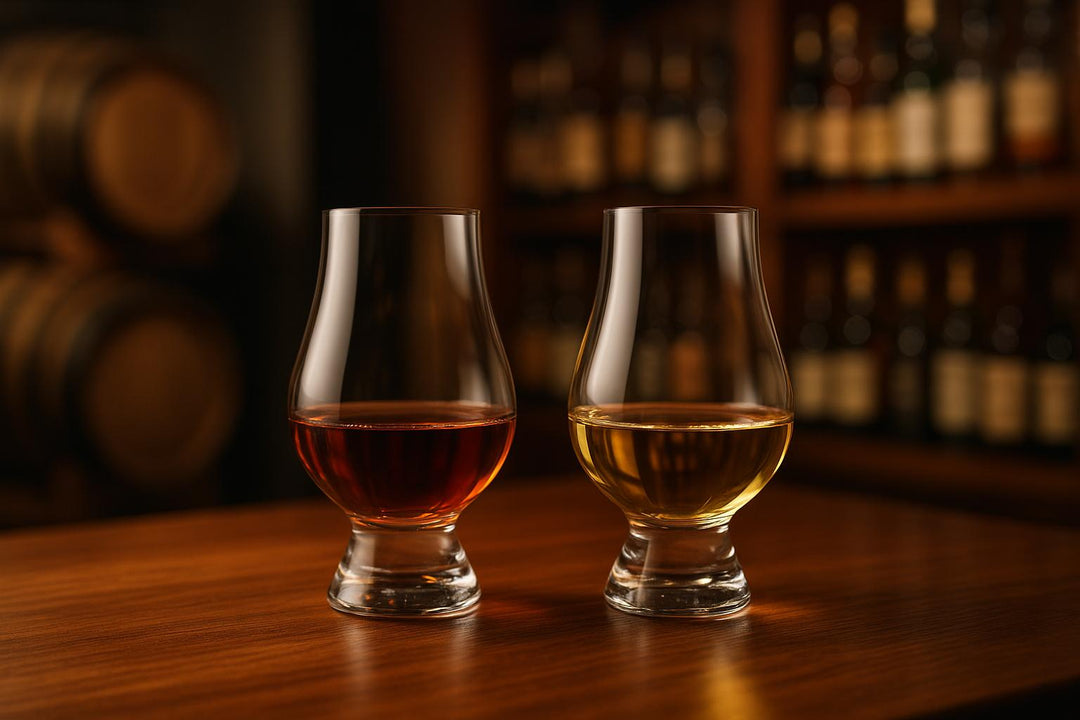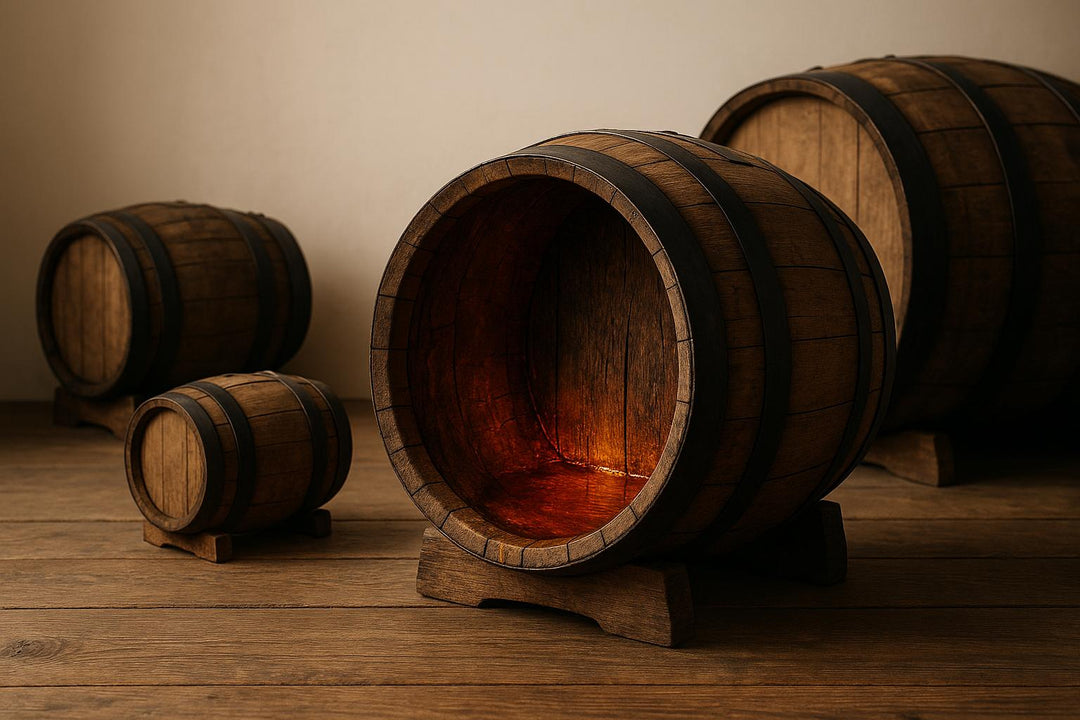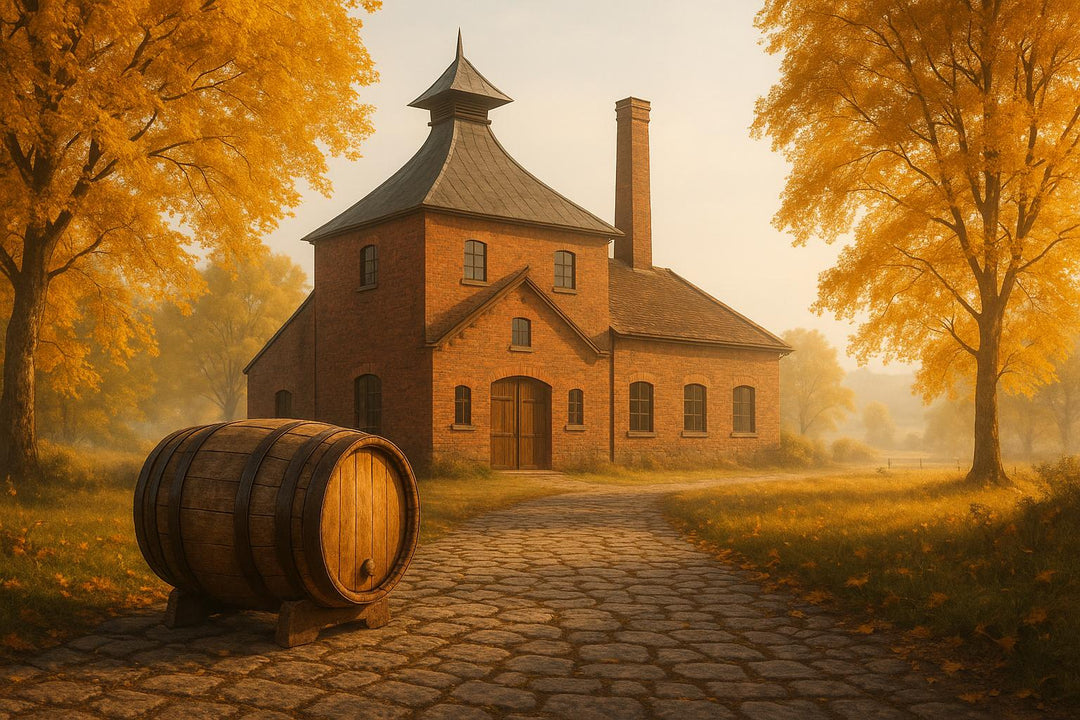Whisky tasting doesn’t have to be intimidating. With a simple five-step process, you can learn to appreciate the nuances of different whiskies and enjoy the experience like a pro. Here’s a quick overview to get started:
- Choose Your Whisky: Pick a style that suits your taste - Scotch, bourbon, Irish, or Japanese whisky. Beginners might start with smooth options like Irish or Speyside Scotch.
- Set Up Your Tasting Space: Use a Glencairn glass and serve whisky at about 68°F for the best experience.
- Look at the Whisky: Observe its color to get clues about its cask type and aging process.
- Smell the Whisky: Take light sniffs and identify aromas using a whisky flavor wheel.
- Taste and Evaluate: Sip slowly, note flavors, texture, and finish, and consider adding water to reveal hidden notes.
For beginners, curated tasting packs like those from The Really Good Whisky Company (starting at $24.99) are a great way to sample different styles without committing to full bottles. Whether you prefer fruity, smoky, or sweet flavors, this guide will help you enjoy every sip.
Step 1: Choose Your Whisky
The journey to enjoying whisky starts with picking the right bottle, and for newcomers, this can feel like stepping into a maze of choices. The trick is to understand the basic differences between whisky styles and begin with ones that align with your taste preferences.
When exploring, consider the distinct characteristics of each whisky style. For instance, Scotch whisky varies by region. If you prefer fruity notes, Speyside is a great place to start. For those who enjoy bold, smoky flavors, Islay whiskies bring intense peatiness. Highland and Lowland whiskies, on the other hand, offer more balanced and approachable profiles.
American whisky, especially bourbon, provides an entirely different experience. By law, bourbon must contain at least 51% corn in its mash bill, giving it a sweeter and smoother profile compared to Scotch. Expect flavors like vanilla, oak, and toffee. Greg Dillon, Editor of GreatDrams, puts it this way:
Essentially anyone can get into bourbon – particularly if they're interested in trying whisky but not necessarily ready to start with Scotch and deal with the pretentiousness around it.
Another excellent choice for beginners is Irish whisky, known for its smooth and light character, thanks to its triple distillation process. Greg Dillon highlights its appeal:
Irish whisky producers have been really good at adding personality to the market and making their whisky feel like it's a really chilled-out drink, so something you'd enjoy with friends or on your own.
For those seeking something unique yet approachable, Japanese whisky strikes a fine balance. While it draws inspiration from Scotch, it has a character all its own. Chris Walster from The Cask Connoisseur describes it as:
I often think of Japanese whisky as a smooth, delicate, and balanced whisky, which can either be floral or fruity... Because of its delicate and complex nature, it's often thought of as the perfect combination for newcomers and connoisseurs alike.
Japanese whisky also stands out for its use of mizunara oak casks, which add a distinct floral spiciness to the flavor profile.
While age can indicate complexity, keep in mind that American bourbons tend to mature faster than Scotch, meaning younger bourbons can still deliver rich flavors. For those just starting out, blended whiskies are another great option. They provide consistent and approachable flavors that are easy to enjoy. As Greg Dillon notes:
Blends are for everyone. There are so many different styles to work your way through.
If you're unsure where to start, consider trying a whisky tasting pack, like those offered by The Really Good Whisky Company. These packs let you sample a variety of styles without committing to full bottles. They also make it easier to compare different types side by side - like a smooth Speyside versus a smoky Islay, or the vanilla sweetness of bourbon against the floral delicacy of Japanese whisky. This hands-on approach can help you discover your personal favorites much faster.
To begin your whisky journey, explore a diverse range of styles. Sampling regional expressions will help you build a broad foundation of flavors. Once you find what you love, you can dive deeper into specific styles and truly savor the experience.
Step 2: Set Up Your Tasting Space
Creating the right environment for whisky tasting can make all the difference in how you experience its aromas and flavors. The right glassware and serving temperature can elevate your enjoyment and help you pick up on subtle nuances.
Choose the Right Glassware
Believe it or not, the glass you choose can significantly impact what you smell and taste. Dr. Dwight Furrow, WSET Advanced Certified, puts it best:
"If you like to taste, analyze and fully appreciate what you're drinking, don't ignore the glass. The type of glass you use will affect what you smell and taste."
For whisky enthusiasts, the Glencairn glass is often considered the go-to option. At around $7.99, this glass is designed with a wide bowl for inspecting color and a tapered neck to concentrate aromas, making it ideal for a more refined tasting experience.
Another excellent choice is tulip-shaped glasses, which are particularly good at enhancing aroma and providing a precise sip. Research from Brock University backs this up, showing that tulip-shaped glasses can heighten flavor perception. On the other hand, shot glasses, wide tumblers, and even cognac glasses aren't the best picks - they either fail to concentrate aromas or mask the whisky's subtler notes.
Set the Perfect Temperature
Temperature is another key factor in whisky tasting. Aim to serve whisky at about 68°F. This temperature helps balance the alcohol's potency with the more delicate flavors. If you're tasting on a warm day, consider chilling the bottle instead of adding ice, which can dilute the whisky and alter its profile.
Step 3: Look at the Whisky
Pour 1–2 oz of whisky into your glass and take a moment to observe its color. This visual step sets the stage for uncovering the aromas and flavors you'll explore next.
What the Color Can Tell You
The color of whisky offers clues about its journey. Since about 60% of a whisky's flavor comes from its interaction with the cask, its appearance can hint at what flavors lie ahead. Typically, the longer a whisky matures, the deeper its color becomes as it absorbs compounds from the wood.
Cask type plays a big role in shaping a whisky's hue. For example:
- A light golden color often points to time spent in bourbon casks, which contribute notes of vanilla, butter, and caramel.
- A rich golden tone suggests European oak casks, known for adding spicier, woodier characteristics with hints of vanilla and pepper.
- A coppery shade is a telltale sign of sherry cask maturation, which can bring richer, fruitier notes.
What Else Affects the Appearance?
It’s not just age that influences a whisky’s color. Other factors include:
- Cask size: Smaller casks speed up color absorption, often producing more vibrant hues.
- Cask reuse: Each time a cask is reused, it imparts less color to the whisky.
- Maturation temperature: Warmer conditions enhance the solubility of coloring agents, leading to quicker and more intense color changes.
However, it’s worth noting that some distilleries use caramel coloring (E150) to ensure consistent color across batches. So while color can provide insights, it’s not always a definitive indicator of age or cask influence.
sbb-itb-128d6c1
Step 4: Smell the Whisky
Once you've taken in the whisky's color, it's time to shift your focus to its aroma. Smelling, or "nosing", is a crucial part of the experience - aroma makes up about 80% of flavor perception. By dedicating time to properly explore the whisky's scent, you'll uncover layers of complexity that might otherwise remain hidden. Here’s how to approach this step with care and precision.
Mastering the Nosing Technique
Start by holding the glass a few inches from your nose and taking light, gentle sniffs. This distance helps prevent the alcohol from overpowering your senses, allowing you to ease into the aromas. Ewan Morgan, brand ambassador and head of whisky outreach for Diageo, offers a helpful tip:
"If the glass is a clock face, you start your nose just above the 12 position. Then, keep your mouth open and move down to the six. Don't shove your nose in the glass, though: this is how you go 'nose blind,' making it challenging to discern smells."
To enhance the experience, keep your mouth slightly open. This combines nasal and oral breathing, softening any sharpness and making it easier to detect subtle notes.
The French Technique for Delicate Aromas
When working with whiskies that have faint or elusive scents, try the French Technique. Hold the glass at stomach level and slowly lift it while sniffing. The moment you catch an aroma, stop and bring the glass just 1–2 inches closer. This approach helps you find the ideal distance where the whisky's character is clear but not overpowered by alcohol.
If you sense harsh alcohol or feel a sharp sting in your nose, move the glass back slightly. The goal is to locate that "sweet spot" where the aromas are vibrant and balanced.
Experimenting with Angles and Breathing
Play around with the angle of the glass. Hold it perpendicular to your face and vary your breathing patterns, alternating between short sniffs and long, deep inhales. This variation can reveal different layers of the whisky's aroma.
Using the Whisky Flavor Wheel
Once you've familiarized yourself with the scents, use the Whisky Flavor Wheel as a guide. Originally developed by the Scotch Whisky Research Institute in the late 1970s, this tool remains a trusted resource for identifying aroma and flavor profiles. The wheel organizes whisky scents into broad categories, which then branch into more detailed notes.
Here are a few broad categories to start with:
- Fruity: Notes like apples, pears, citrus, or dried fruits
- Floral: Scents of rose petals, lavender, or fresh meadows
- Smoky: Hints of peat smoke, wood smoke, or ash
- Spicy: Touches of black pepper, cinnamon, nutmeg, or ginger
- Woody: Aromas of oak, cedar, or vanilla from the cask
Begin by identifying a general category, then use the wheel to narrow it down to specific notes. Don’t stress if you can’t detect everything right away - your sense of smell will improve with practice, and every whisky offers a chance to learn something new.
Take your time with this step. Let the whisky breathe and notice how the aromas evolve as it interacts with air. Some scents will hit you immediately, while others may take a few minutes to reveal themselves. Savor the process - it’s all part of the journey.
Step 5: Taste and Evaluate the Whisky
Now it’s time to bring everything together - what you’ve seen, smelled, and now, tasted. This step is about connecting the whisky’s visual and aromatic qualities with its flavor. Start small, with gentle sips, to let your palate adjust and uncover the layers within.
The First Sip: Setting the Stage
Take a small, teaspoon-sized sip and let it coat your palate. Don’t rush - give it a moment to settle before taking another sip. Pay close attention to how the flavors develop and shift with each taste.
Breaking Down Flavor, Texture, and Mouthfeel
As you sip, try to pinpoint specific flavors. Is it fruity, smoky, floral, spicy, or perhaps savory? Then, notice the texture - does it feel velvety, oily, dry, or creamy? Finally, observe the mouthfeel. These elements give clues about how the whisky was distilled, aged, and the type of casks used.
The Finish: What Lingers
After swallowing, focus on the finish - the flavors that linger. A short finish might indicate a lighter profile, while a longer one often hints at more complexity. This lingering taste is an essential part of the whisky’s character.
Using Water to Unlock Flavors
Adding water can be a game-changer. Just 2–3 drops can reduce the alcohol’s intensity and bring hidden flavors to the forefront. Try tasting after each addition to notice how the profile evolves.
This method works especially well with cask-strength whiskies, which can be quite powerful. Don’t worry - adding water doesn’t dilute the whisky’s quality; instead, it can reveal nuances that might otherwise stay masked by the alcohol.
The Value of a Tasting Journal
Keeping a tasting journal is a great way to document your experience. Write down details like the whisky’s name, ABV, appearance, nose, palate, texture, finish, and your impressions with or without water. Over time, this record will help you discover patterns in your preferences and refine your tasting skills.
Avoiding Common Pitfalls
Take your time. Don’t rush through sips - let your palate rest between tastes so you can fully appreciate how the flavors unfold. Avoid taking large gulps or slurping, as these can overwhelm your senses.
Above all, trust your own palate. Your experience is valid, even if it doesn’t match expert notes or others’ opinions. Your tasting journal will become a personal roadmap of your whisky journey, helping you grow more confident with every bottle you try.
Conclusion
Every bottle of whisky tells a story, adding depth and character to your tasting journey. The five steps we’ve discussed - choosing the right whisky, preparing your space, examining its appearance, exploring the aromas, and savoring the taste - offer a clear path to turn casual drinking into a thoughtful and rewarding experience.
As you practice, picking out flavors and finishes will feel more natural, and your tasting journal will become a personal guide to discovering what you love most.
Ready to take the next step? Check out our curated tasting packs, perfect for refining your skills. The Really Good Whisky Company offers carefully selected options like the Single Malt Whisky Gift Set with Glencairn Whisky Glass ($39.99), The American Whiskey Tasting Pack with Online Video Link ($24.99), Islay Scotch Single Malt Whisky Tasting Pack ($24.99), and the Whisky Tasting Gift Box 10 Malts to Try ($69.99). Each pack comes with detailed tasting notes, making it easy and enjoyable to explore different styles and regions.
FAQs
How can I find the right whisky style for my taste as a beginner?
Finding your ideal whisky as a beginner is all about exploring and experimenting. Start by sampling a variety of types, such as bourbon, Irish whiskey, Scotch, or rye, each offering its own distinct character. For instance, bourbon often carries a sweeter profile with hints of vanilla and caramel, while Scotch can range from light and floral to bold and smoky.
To ease into the world of whisky, begin with milder, more approachable options. Pay attention to the flavors that stand out to you - whether it’s sweetness, spice, or a touch of smokiness. Try tasting small amounts and consider adding a splash of water to reveal hidden layers of flavor and aroma. As you explore, you’ll gradually refine your palate and gain the confidence to dive into more complex styles.
What should I consider when setting up the perfect environment for whisky tasting?
To set up the ideal environment for whisky tasting, pick a quiet, well-lit space where distractions are minimal. This ensures you can concentrate fully on the whisky's aromas, flavors, and appearance. Aim to keep the room at a comfortable temperature, ideally between 68-72°F, as this helps maintain the whisky's true character.
Steer clear of strong odors like cooking smells or scented candles, as these can mask the delicate aromas of the whisky. A clean, neutral space with little to no background noise will elevate your sensory experience, making it easier to savor every detail of the tasting.
Why should I add water to whisky, and how do I do it properly?
Adding a splash of water to whisky can bring out its full range of flavors by mellowing the alcohol and unveiling subtle aromas and taste notes that might otherwise be overshadowed. This can be particularly useful with high-proof or more intricate whiskies, where the intensity of the alcohol can dominate gentler flavors.
The key is to go slow - start with just a few drops of water and taste as you adjust. This step-by-step method lets you find the right balance for your personal preference without watering down the whisky too much. There’s no universal rule here; it’s all about tailoring the experience to suit your taste!







Leave a comment